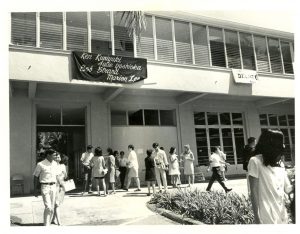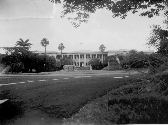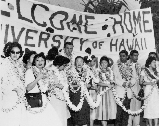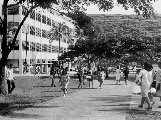Miyamoto Photograph Collection
 Biographical Sketch
Biographical Sketch
Masao Miyamoto, the youngest of five children, was born in Kona to coffee farmers. When he was six his parents moved to the Kaimukī area of Honolulu.1 Miyamoto had two life-long commitments outside his home: Scouting and photography. He joined Troop 10 of the Boy Scouts at age twelve in 1925, and completed the requirements for Eagle Scout in 1932. At around the same time, he became Assistant Scoutmaster of his troop. When the founding Scoutmaster of Troop 10 retired in 1945, Miyamoto became its second Scoutmaster 10, continuing in this position until April 12th, 1992.2
Scouting led Miyamoto to his second life-long career: photography. After learning photography in the Scouts, he continued his hobby during his student years at McKinley High School, where he was president of the photography club and photographer for the Daily Pinion. After graduating in 1932, he took a job with the silent movie library at the University of Hawaiʻi. Eventually he persuaded University officials to hire him as a photographer.3
Miyamoto began his career as official photographer for the University on April 1st, 1936. Over the next forty-one years he photographed four Presidents of the United States, eleven Presidents of the University of Hawaiʻi, and captured the images of numerous foreign dignitaries and national leaders, including President Sukarno of Indonesia, Madame Chiang Kai-shek, Professor Daisetsu Suzuki, Mr. Ralph Bunch, and Dr. Martin Luther King, Jr. Though Miyamoto officially retired on the last day of June 1977 he continued his photography work at the University, volunteering four hours per day for the next fourteen years. In February 1991, the Masao Miyamoto Photograph Collection—numbering approximately 70,000 negatives—came to the University Archives.
Masao Miyamoto passed away November 19th, 1995 at his home in Mānoa. Concerning his life, one of his former scouts said: “If anyone ever wonders whether or not a single person can make a difference in this world, they need only look at Masao Miyamoto and his life of service.”4
Notes
1 “Masao Miyamoto,” Honolulu Star Bulletin, 22 November 1995, p. A9.
2 ” — ,” Honolulu Advertiser, 12 April 1992, p. E1.
3Star Bulletin, ibid.
4ibid.
Collection Description
Masao Miyamoto grouped the photographs into three main categories:
- The smallest category consists of images Miyamoto rescued, primarily when the University administration moved from Hawaiʻi Hall to the newly completed Bachman Hall around 1953. Having heard that people were dumping photographs, Miyamoto rescued numerous images, including glass plate and film based negatives illustrating the first two decades of had at the time been known as the College of Hawaiʻi.
- The second group, consisting of four subgroups, documents the faculty and staff of the University of Hawaiʻi. There is a relatively small group of photos ranging from 1948 to 1955; this is followed by around twice as many images from 1955 to 1964. Next comes a large group—holding over ten times the number of negatives as in the first group—that covers faculty and staff from 1965 to approximately 1980. The last remaining set of photographs in this category consists of a small number of miscellaneous photographs which possibly should be interfiled into the three chronological subseries.
- Miyamoto classified the final category of photographs, “Events.” Similar to his treatment of faculty photographs—where he assigned a number to the faculty person, not a separate number to each image he created of the faculty person—Miyamoto assigned numbers to each event he photographed. Thus a single event number might refer to only one photograph, but usually covers numerous images. Although another numbering system was created for storage purposes (see below), Miyamoto’s numbering has been recorded with the images for future reference.
At the time the collection was donated the University Archivist decided to create another numbering system in order to store negatives efficiently by size and to expedite retrieval. This system involved sorting the collection according to the size of the negatives. These assigned item numbers begin with a capital letter representing the size of the negative, followed by two digits representing the year, a colon, and three digits for chronological ordering within each year. The letter “A” indicates 4 x 5″ negatives as well as some early odd sized negatives; the letter “B” indicates 120 mm negatives; and the letter “C” indicates 35 mm negatives.
For the viewing public, the major disadvantage of the Miyamoto Collection is that it includes only a scattering of positive prints. When prints are available, the archival staff pull them for patrons to view; but when only negatives exist, those are brought. Additionally, patrons using University Archives photographs must wear cotton gloves, supplied by the University Archives & Manuscripts Department.
Finding Aid and Inventories
Photograph Indexes:
- Alphabetical Listing Part 1: Dates and numbers – L
- Alphabetical Listing Part 2: M – Z
- Chronological Listing Part 1: Photographs from the 1940s
- Chronological Listing Part 2: Photographs from the 1950s
- Chronological Listing Part 3: Photographs from the 1960s
- Chronological Listing Part 4: Photographs from the 1970s-1980s and undated photographs
- Photographs of Faculty

- Photographs of Students & Others

- Photographs of Events

Selection of Digitized Photographs
 This image was scanned from a photographic print. Click on the thumbnail to view a larger version of the image.
This image was scanned from a photographic print. Click on the thumbnail to view a larger version of the image.
- NEG NUMBER — A48-00007
- DATE — 1948 / 00
- EVENT — Hawaiʻi Hall
- LOCATION — Hawaiʻi Hall
- PERSONNEL —
- SUMMARY — ʻEwa views of Hawaiʻi Hall; prints taken from odd-sized negatives
- NO. OF FRAMES — 4
- MIYAMOTO NO. — L-15
- OTHER INFO — 3 prints, 3 odd-sized negs.
 This image was scanned from a photographic print. Click on the thumbnail to view a larger version of the image.
This image was scanned from a photographic print. Click on the thumbnail to view a larger version of the image.
- NEG NUMBER — B58-00014
- DATE — 1958 / 00
- EVENT — UH Choir Back From Japan Tour
- LOCATION — Airport
- PERSONNEL —
- SUMMARY — Views of old airport, choir, reception
- NO. OF FRAMES — 23
- MIYAMOTO NO. — R-1583
- OTHER INFO —
 This image was scanned from a photographic print. Click on the thumbnail to view a larger version of the image.
This image was scanned from a photographic print. Click on the thumbnail to view a larger version of the image.
- NEG NUMBER — C66-00080
- DATE — 1966 / 00
- EVENT — Spalding Hall and The Mall with Students
- LOCATION — Spalding Hall, The Mall
- PERSONNEL —
- SUMMARY — Campus photos
- NO. OF FRAMES — 35
- MIYAMOTO NO. — 35-66-251
- OTHER INFO —
These images were scanned from photographic negatives using the Library’s slide scanner. Click on the thumbnail to view larger versions of each image.
- NEG NUMBER — C69-00096
- DATE — 1969 / 09
- EVENT — Ralph Bunche
- LOCATION —
- PERSONNEL — Bunche, Ralph, U.N. President; Burns, John
- SUMMARY — Looks like speaking to an outdoor audience at night
- NO. OF FRAMES — 48
- MIYAMOTO NO. — 35-69-704
- OTHER INFO —




